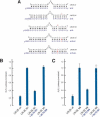A combined computational-experimental approach predicts human microRNA targets
- PMID: 15131085
- PMCID: PMC415641
- DOI: 10.1101/gad.1184704
A combined computational-experimental approach predicts human microRNA targets
Abstract
A new paradigm of gene expression regulation has emerged recently with the discovery of microRNAs (miRNAs). Most, if not all, miRNAs are thought to control gene expression, mostly by base pairing with miRNA-recognition elements (MREs) found in their messenger RNA (mRNA) targets. Although a large number of human miRNAs have been reported, many of their mRNA targets remain unknown. Here we used a combined bioinformatics and experimental approach to identify important rules governing miRNA-MRE recognition that allow prediction of human miRNA targets. We describe a computational program, "DIANA-microT", that identifies mRNA targets for animal miRNAs and predicts mRNA targets, bearing single MREs, for human and mouse miRNAs.
Figures






Similar articles
-
STarMir Tools for Prediction of microRNA Binding Sites.Methods Mol Biol. 2016;1490:73-82. doi: 10.1007/978-1-4939-6433-8_6. Methods Mol Biol. 2016. PMID: 27665594 Free PMC article.
-
Progress in miRNA target prediction and identification.Sci China C Life Sci. 2009 Dec;52(12):1123-30. doi: 10.1007/s11427-009-0159-4. Epub 2009 Dec 17. Sci China C Life Sci. 2009. PMID: 20016969 Review.
-
Analysis of microRNA-target interactions by a target structure based hybridization model.Pac Symp Biocomput. 2008:64-74. Pac Symp Biocomput. 2008. PMID: 18232104
-
Prediction and verification of microRNA targets by MovingTargets, a highly adaptable prediction method.BMC Genomics. 2005 Jun 8;6:88. doi: 10.1186/1471-2164-6-88. BMC Genomics. 2005. PMID: 15943864 Free PMC article.
-
Prediction of human microRNA targets.Methods Mol Biol. 2006;342:101-13. doi: 10.1385/1-59745-123-1:101. Methods Mol Biol. 2006. PMID: 16957370 Review.
Cited by
-
MicroRNA degeneracy and pluripotentiality within a Lavallière-tie architecture confers robustness to gene expression networks.Cell Mol Life Sci. 2016 Aug;73(15):2821-7. doi: 10.1007/s00018-016-2186-1. Epub 2016 Apr 1. Cell Mol Life Sci. 2016. PMID: 27038488 Free PMC article.
-
The Role of miR-212 and iNOS in Alcohol-Induced Intestinal Barrier Dysfunction and Steatohepatitis.Alcohol Clin Exp Res. 2015 Sep;39(9):1632-41. doi: 10.1111/acer.12813. Epub 2015 Jul 24. Alcohol Clin Exp Res. 2015. PMID: 26207424 Free PMC article.
-
MicroRNA: A Bridge from H. pylori Infection to Gastritis and Gastric Cancer Development.Front Genet. 2012 Dec 14;3:294. doi: 10.3389/fgene.2012.00294. eCollection 2012. Front Genet. 2012. PMID: 23248648 Free PMC article.
-
MicroRNA-93 may control vascular endothelial growth factor A in circulating peripheral blood mononuclear cells in acute Kawasaki disease.Pediatr Res. 2016 Sep;80(3):425-32. doi: 10.1038/pr.2016.93. Epub 2016 Apr 18. Pediatr Res. 2016. PMID: 27089500
-
Predicting kissing interactions in microRNA-target complex and assessment of microRNA activity.Nucleic Acids Res. 2012 May;40(10):4681-90. doi: 10.1093/nar/gks052. Epub 2012 Feb 3. Nucleic Acids Res. 2012. PMID: 22307238 Free PMC article.
References
-
- Abrahante J.E., Daul, A.L., Li, M., Volk, M.L., Tennessen, J.M., Miller, E.A., and Rougvie, A.E. 2003. The Caenorhabditis elegans hunchback-like gene lin-57/hbl-1 controls developmental time and is regulated by microRNAs. Dev. Cell 4: 625–637. - PubMed
-
- Ambros V., Lee, R.C., Lavanway, A., Williams, P.T., and Jewell, D. 2003b. MicroRNAs and other tiny endogenous RNAs in C. elegans. Curr. Biol. 13: 807–818. - PubMed
Publication types
MeSH terms
Substances
Grants and funding
LinkOut - more resources
Full Text Sources
Other Literature Sources
Molecular Biology Databases
